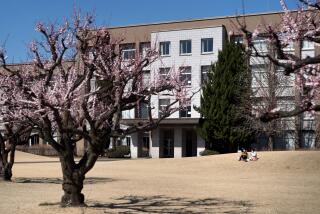Frugality? Phooey! : Some Economists Suggest Japanese Should Save Less and Spend More
- Share via
TOKYO — Izumi Kondo’s family has no automobile. There is no air conditioning in her house. She won’t turn on the heat until the temperature falls below 41 degrees. The family diet consists of low-cost fish, beans, vegetables and rice--healthy fare that Kondo is convinced saves on medical bills as well.
Such thrift, meticulously recorded in household account books kept by Kondo for 25 years, has enabled the 51-year-old housewife to guarantee that all four of her children will go to college, despite her husband’s modest salary as a civil servant.
The kinds of privations the Kondos endure help explain how Japanese families manage to save 14% of their incomes on average--about twice what American families put away, even with Japan’s far higher cost of living.
But while some economists like to talk of the Japanese “cultural propensity to save,” scholars say Japan’s high savings rates are the result of a well-focused government effort over the past century to promote savings and discourage consumption.
“There is a conscious effort to mold this culture to promote savings,” says Sheldon Garon, professor of Japanese history at Princeton University.
A national savings council organizes study groups, school curricula and seminars nationwide to promote savings. In October, the council will renew a slick multimillion-dollar advertising campaign urging citizens to better “plan . . . so you can achieve your dream.” Planning is a code word for boosting savings.
Japan’s Spartan public welfare system for the aged and infirm encourages saving among even the most destitute. Living with his wife in a converted charcoal-storage shed, Tetsuo Kato, 67, stashes part of his monthly welfare check in a bank account to cover nursing care should he be hospitalized--an expense not covered by national health care.
Now, though, many economists--in a view echoed by Japan’s new reformist prime minister, Morihiro Hosokawa--think its no longer such a good idea for the Japanese to be saving so much. What Japan must learn, they say, is not how to save but how to spend.
Japan’s economy is suffering its worst recession in decades. Exports won’t help, because the strong yen is making Japanese products too costly. Investments in factories, the key engine for growth in the past, also are depressed by overcapacity. So economists say consumption may be the only way to pull the economy out of its slump.
More domestic consumption also would boost imports, helping stem the growing trade surplus that is exacerbating trade friction with the United States and the rest of the world. Even a proposed tax cut to stimulate the economy could have limited impact, economists say, if a large portion of the additional take home pay is simply siphoned off into savings.
But Japanese government finance officials insist it is critical for Japan to maintain its thriftiness to avoid slipping into the high consumption patterns that they believe undermine the economies of the United States and Britain.
“Maybe temporarily it is OK to promote consumption. But long-term (savings are) important to live a prosperous life,” says Kazuo Sato, deputy director of the information bureau for the Central Council for Savings Information. He cites demographic statistics showing that a shrinking group of wage earners will soon be supporting a growing population of retirees.
The savings council--the strategic command post for Japan’s national savings promotion effort--is an example of how Japan has mobilized its private and public resources to promote the national goal of high savings rates.
It sits atop a nationwide network of dozens of smaller councils that include bankers, government officials and local dignitaries who work with grass-roots women’s and consumer organizations to promote the cause. South Korea, which has an even higher savings rate than Japan, has modeled its savings promotion effort after Japan’s. Some Japanese argue that Americans would be wise to take heed if they are seriously interested in increasing savings rates.
During Japan’s early period of modernization, the council was an official government organization that set savings goals for each prefecture. It later became a private group, but officials in the Bank of Japan’s information office continue to help administer the program, and local governments are required to promote it.
Through city councils and prefectural offices, an army of 1,253 savings advisers works with thousands of study groups around the country to discuss the import role fat bank accounts play in dealing with inheritance taxes, retirement, housing purchases and future travel plans.
A major concern is the education of Japan’s young who, born into prosperity, are regarded as less thrifty.
For 20 years, the council has been working with model schools where classes in every subject area are shaped to promote savings. A physics lesson, for example, compares the nature of light to the use of a credit card. (Both consume something that is not visible to the user.) There are now 125 schools involved in the program and new schools join every year.
A new comic book for junior high school students, scheduled for wide distribution this year, notes that Japanese savings not only build factories in Japan but fuel development in the rest of the world.
An animated video distributed to schools, “The Greedy Princess,” tells the story of a spoiled little girl who doesn’t understand the importance of money until she is mistakenly thrown out into the wilderness and forced to work for a living.
The savings promotions appear to be having an impact on young people.
In an essay that won a special Bank of Japan Governor’s award, sixth grader Fuchigami Seiko gives a persuasive argument for savings: “There are more than 100 million people in Japan. If each person wastes one yen, then Japan will waste a 100 million yen. On the other hand, if each person saves one yen, then Japan’s savings will grow by 100 million yen. That will make this country more prosperous. So I will continue to save even one yen.”
Even Japan’s consumer-conscious university students seem to be coming aboard. According to recent surveys, students save more than 20% of their allowances and the money earned from part-time jobs.
Among the savings council’s tactics for increasing savings is encouraging Japanese housewives--who traditional take charge of family expenses--to keep careful household accounts. It recently hired several advisers to design a new accounting book specifically targeted at the young.
“Before we focused on recording daily expenses,” says Sato of the savings council. “Now we focus on future dreams and what you have to do to achieve those dreams.”
Savings Rates
Savings Rates in the Industrial World...
Savings as a percentage of gross domestic product, 1991
Percent Rank Country saved 1 Luxembourg 59.4% 2 Japan 35.1 3 Switzerland 31.6 4 Austria 25.5 5 Portugal 25.4 6 Netherlands 25.0 7 Ireland 23.7 8 Norway 23.6 9 Germany 22.5 10 Belgium 21.4 11 Spain 21.3 12 Turkey 21.2 13 France 20.5 14 Italy 18.4 15 Denmark 17.9 16 Finland 16.3 17 Australia 15.6 18 Sweden 15.1 19 New Zealand 15.0 Tie United States 15.0 21 Greece 14.8 22 Canada 14.6 23 Iceland 14.1 24 United Kingdom 13.8
Savings as a percentage of gross domestic product, 1990
Percent Rank Country saved 1 Indonesia 38.35% 2 South Korea 36.7 3 Algeria 36.6 4 Venezuela 34.0 5 People’s Rep. of Congo 29.9 6 Hungary 28.2 7 Nigeria 27.3 8 Columbia 26.7 9 Chile 21.4 10 Tunisia 20.3 11 India 20.0 12 Zimbabwe 19.4 13 Turkey 18.9 Tie Peru 18.9 15 Morocco 18.3 16 Argentina 17.5 17 Cameroon 17.2 18 Philippines 15.8 19 Costa Rica 15.0 20 Guatemala 8.3 21 Malawi 4.4 22 Nepal 3.6 23 Uganda 1.5 24 El Salvador 1.4
Sources: Organization for Economic Co-operation and Development; International Bank for Reconstruction and Development
Researched by ADAM S. BAUMAN / Los Angeles Times
More to Read
Inside the business of entertainment
The Wide Shot brings you news, analysis and insights on everything from streaming wars to production — and what it all means for the future.
You may occasionally receive promotional content from the Los Angeles Times.










